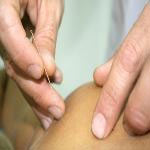
Scientists have taken another important step toward understanding how acupuncture — the ancient Chinese form of needle therapy — actually eases pain.
Acupuncture has been used as a medical treatment for thousands of years, but Western medicine has been slow to adopt the practice, in part because no one could explain how it worked.
One theory was that sticking needles into certain points on the body stimulated the central nervous system to release natural pain-killing endorphins in the brain. But Dr. Maiken Nedergaard, a neuroscientist at the University of Rochester Medical Center in New York, saw a problem with that explanation.
"If you have pain in the leg or in the arm, you give acupuncture close to where you have the pain," she explains. "So, a central mechanism can't explain that, because then it wouldn't matter where you give the acupuncture. So we felt there had to be a local mechanism and that's why we looked into adenosine."
Prodding a natural anesthetic into action
Adenosine is a natural pain killer in our cells, which works like a local anesthetic. It's released after an injury, and inhibits nerve signals so the brain never receives the painful messages. Nedergaard explains that an acupuncture needle starts that process.
"In these cells — the muscle cell and the skin cell — they contain adenosine, but normally they don't release it. But the needle...you can look at it as a small injury. It's not really painful, but still injures many cells," says Nedergaard. "As soon as adenosine is released it is very potent, so even if a few cells are damaged, it would give rise to a fairly substantial amount of adenosine release and reduction of pain."
Acupuncture's effectiveness as a painkiller has sometimes been attributed to the placebo effect; patients with chronic pain expect the procedure to work, and so they feel better after a treatment, even if their pain is not actually lessened.
Nedergaard and her team worked with mice, who, she points out, have no expectations, so their data has not been compromised by the placebo effect. The mice had discomfort in one paw. The researchers measured the level of pain before and after an acupuncture treatment by touching the paw with a filament and measuring the difference in reaction time.
Nedergaard says understanding the biological basis of acupuncture's effects can lead to improved results.
"Chronic pain is a big issue for patients. We don't have very good painkillers for a very large number of patients and they very often get acupuncture treatment," she says. "So, knowing that adenosine is at least one of the mediators of the painkilling effect of acupuncture, you can go in and simply slow the removal of adenosine and thereby the painkilling effect of acupuncture would last longer."
More than three times longer, Nedergaard found. She says participants at the Purines 2010 scientific meeting in Barcelona, where she presented her team's results, were excited about the findings.
"I think for the field itself, it is very easy to accept because the different steps in the [adenosine] pathway have all been described before. It's always been known that small injury gives rise (to) adenosine release, and it's also been known that adenosine is a painkiller. We just put it together that acupuncture is also injury and you get adenosine release."
Dr. Nedergaard is also excited because the drug they used to slow the removal of adenosine — a cancer medication called deoxycoformycin — is already approved by the U.S. government, so human trials may begin soon.
acupuncture: a Chinese method of treating pain and illness using special thin needles which are pushed into the skin in particular parts of the body 針刺療法,針灸
adenosine: (得自酵母核酸的)腺苷酸
placebo effect: 安慰劑效果(指用非藥療安慰劑治療病情好轉(zhuǎn))
filament: a long thin piece of something that looks like a thread 細(xì)絲;絲狀物
(來源:VOA 編輯:陳丹妮)
